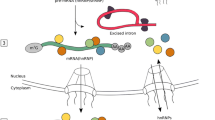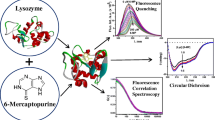Abstract
The irreversible binding of 14C-vinyl chloride metabolites to RNA and DNA of mouse brain, lung, liver, kidney, spleen, pancreas, and testes after a single i.p. injection has been studied. Hydrolysates of nucleic acids from selected organs were separated on Aminex A6 for quantitation of alkylation products.
Radioactivity in nucleic acids was registered in all of the studied organs with the exception of brain. RNA from spleen, pancreas and liver, and DNA from spleen and liver contained the highest amounts of radioactivity. In nucleic acids from spleen and pancreas, both organs of high metabolic activity, the entire radioactivity was found metabolically incorporated as C1-fragments. In RNA of kidney and liver, a large part of the radioactivity was also present as incorporated C1-fragments, but 3,N4-ethenocytidine (in kidney) as well as 1,N6-ethenoadenosine and 1,N6-ethenoadenine (in kidney and liver) were identified as alkylation products. In liver DNA, incorporation of C1-fragments was insignificant, indicating different interactions of vinyl chloride metabolites (C1-fragments and alkylating products) with RNA and DNA. The elution profiles of radioactivity in hydrolysates of liver DNA were dominated by an alkylation product of unknown structure (probably a derivative of deoxyguanosine). Possibly, 1,N6-ethenodeoxyadenosine and 1,N6-ethenoadenine were also present in liver DNA.
The results are consistent with the ability of vinyl chloride to act as a multipotent carcinogen by alkylation of DNA in several tissues.
Similar content being viewed by others
References
Anderson D, Hodge CE, Purchase IFH (1976) Vinyl chloride: Dominant lethal studies in male CD-1 mice. Mutat Res 40: 359–370
Barbin A, Brésil H, Croisy A, Jacquignon P, Malaveille C, Montesano R, Bartsch H (1975) Liver microsome mediated formation of alkylating agents from vinyl bromide and vinyl chloride. Biochem Biophys Res Commun 67: 596–603
Barrio JR, Secrist JA, Leonard NJ (1972) Fluorescent adenosine and cytidine derivatives. Biochem Biophys Res Commun 46: 597–604
Bartsch H, Malaveille C, Montesano R (1975) Human, rat and mouse liver-mediated mutagenicity of vinyl chloride in S. typhimurium strains. Int J Cancer 15: 429–437
Berk PD, Martin JF, Young RS, Creech J, Selikoff IJ, Falk H, Watanabe P, Popper H, Thomas L (1976) Vinyl chloride associated liver disease. Ann Intern Med 84: 717–731
Block JB (1974) Angiosarcoma of the liver following vinyl chloride exposure. JAMA 229: 53–54
Brookes P (1977) Role of covalent binding in carcinogenicity. In: Jollow DJ, Kocsis JJ, Snyder R, Vainio H (eds) Biological reactive intermediates. Formation, toxicity, and inactivation. Plenum Press, New York, pp 470–480
Burton K (1956) A study of the conditions and mechanism of the diphenylamine reaction for the colorimetric estimation of deoxyribonucleic acid. Biochem J 62: 315–323
Creech JL, Johnson MN (1974) Angiosarcoma of liver in the manufacture of polyvinyl chloride. J Occup Med 16: 150–151
Drevon C, Kuroki T (1979) Mutagenicity of vinyl chloride, vinylidene chloride, and chloroprene in V79 Chinese hamster cells. Mutat Res 67: 173–182
Elmore JD, Wong JL, Laumbach AD, Streips UN (1976) Vinyl chloride mutagenicity via the metabolites chlorooxirane and chloroacetaldehyde monomer. Biochim Biophys Acta 442: 405–419
Falk H, Creech JL, Heath CW, Johnson MN, Key MM (1974) Hepatic disease among workers at a vinyl chloride polymerization plant. JAMA 230: 59–63
Fox AJ, Collier PF (1977) Mortality experience of workers exposed to vinyl chloride monomer in the manufacture of polyvinyl chloride in Great Britain. Br J Ind Med 34: 1–10
Green T, Hathway DE (1975) The biological fate in rats of vinyl chloride in relation to its oncogenicity. Chem Biol Interact 11: 545–562
Green T, Hathway DE (1977) The chemistry and biogenesis of the S-containing metabolites of vinyl chloride in rats. Chem Biol Interact 17: 137–150
Green T, Hathway DE (1978) Interactions of vinyl chloride with rat liver DNA in vivo. Chem Biol Interact 22: 211–224
Greim H, Bonse G, Radwan A, Reichert D, Henschler D (1975) Mutagenicity in vitro and potential carcinogenicity of chlorinated ethylenes as a function of metabolic oxirane formation. Biochem Pharmacol 24: 2013–2017
Gross H (1963) Monochloracetaldehyde bzw. Derivate des Glykolaldehyds und Glyoxals aus α-Halogenäthern. J Prakt Chem 21: 99–102
Guengerich FP, Watanabe PG (1979) Metabolism of (14C)-and (36Cl)-labeled vinyl chloride in vivo and in vitro. Biochem Pharmacol 28: 589–596
Hall JA, Saffhill R, Green T, Hathway DE (1981) The induction of errors during in vitro DNA synthesis following chloroacetaldehyde treatment of poly(dA-dT) and poly(dC-dG) templates. Carcinogenesis 2: 141–146
Hefner RE, Watanabe PG, Gehring PJ (1975) Preliminary studies of the fate of inhaled vinyl chloride monomer in rats. Ann NY Acad Sci 246: 135–148
Holmberg B, Kronevi T, Winell M (1976) The pathology of vinyl chloride exposed mice. Acta Vet Scand 17: 328–342
Infante PF, Wagoner JK, Waxweiler RJ (1976) Carcinogenic, mutagenic, and teratogenic risks associated with vinyl chloride. Mutat Res 41: 131–142
Irving CC, Veazey RA (1968) Isolation of deoxyribonucleic acid and ribosomal ribonucleic acid from rat liver. Biochim Biophys Acta 166: 246–248
Kappus H, Bolt HM, Buchter A, Bolt W (1975) Rat liver microsomes catalyse covalent binding of 14C-vinyl chloride to macromolecules. Nature 257: 134–135
Laib RJ, Bolt HM (1977) Alkylation of RNA by vinyl chloride metabolites in vitro and in vivo: formation of 1,N6-ethenoadenosine. Toxicology 8: 185–195
Laib RJ, Bolt HM (1978) Formation of 3,N4-ethenocytidine moieties in RNA by vinyl chloride metabolites in vitro and in vivo. Arch Toxicol 39: 235–240
Laib RJ, Ottenwälder H (1978) Alkylation of DNA and RNA by metabolites of vinyl chloride and vinyl bromide. Naunyn Schmiedebergs Arch Pharmacol (Suppl 1) 302: R21
Laib RJ, Gwinner LM, Bolt HM (1981) Alkylation of DNA by vinyl chloride metabolites: formation of 7-N-(2-oxoethyl)guanine. J Cancer Res Clin Oncol 99: A33-A34
Lee CC, Bhandari JC, Winston JM, House WB (1978) Carcinogenicity of vinyl chloride and vinylidene chloride. J Toxicol Environ Health 4: 15–30
Lloyd JW (1975) Angiosarcoma of the liver in vinyl chloride/polyvinyl chloride workers. J Occup Med 17: 333–334
Maltoni C (1976) Carcinogenicity of vinyl chloride: Current results. Adv Tumor Prev Detect Charact 3: 216–237
Monson RR, Peters JM, Johnson MN (1974) Proportional mortality among vinyl chloride workers. Lancet August 17: 397–398
Osterman-Golkar S, Hultmark D, Segerbäck D, Calleman CJ, Göthe R, Ehrenberg L, Wachtmeister CA (1977) Alkylation of DNA and proteins in mice exposed to vinyl chloride. Biochem Biophys Res Commun 76: 259–266
Rannug U, Johansson A, Ramel C (1974) The mutagenicity of vinyl chloride after metabolic activation. Ambio 3: 194–197
Rannug U, Göthe R, Wachtmeister CA (1976) The mutagenicity of chloroethylene oxide, chloroacetaldehyde, 2-chloroethanol and chloroacetic acid, conceivable metabolites of vinyl chloride. Chem Biol Interact 12: 251–263
Schneider WC (1957) Determination of nucleic acids in tissues by pentose analysis. Methods Enzymol 3: 680–684
Short RD, Minor JL, Winston JM, Lee CC (1977) A dominant lethal study in male rats after repeated exposures to vinyl chloride. J Toxicol Environ Health 3: 965–968
Singer B (1975) The chemical effects of nucleic acid alkylation and their relation to mutagenesis and carcinogenesis. In: Cohn WE (ed) Progress in nucleic acid research and molecular biology, vol 15. Academic Press, New York, pp 219–284
Suzuki Y (1978) Pulmonary tumors induced in mice by vinyl chloride. Environ Res 16: 285–271
Tabershaw IR, Gaffey WR (1974) Mortality studies of workers in the manufacture of vinyl chloride and its polymers. J Occup Med 16: 509–518
Verburgt FG, Vogel E (1977) Vinyl chloride mutagenesis in Drosophila melanogaster. Mutat Res 48: 327–336
Watanabe PG, McGowan GR, Gehring PJ (1976) Fate of (14C)vinyl chloride after single oral administration in rats. Toxicol Appl Pharmacol 36: 339–352
Waxweiler RJ, Stringer W, Wagoner JK, Jones J (1976) Neoplastic risk among workers exposed to vinyl chloride. Ann NY Acad Sci 271: 40–48
Zajdela F, Croisy A, Barbin A, Malaveille C, Tomatis L, Bartsch H (1980) Carcinogenicity of chloroethylene oxide, an ultimate reactive metabolite of vinyl chloride, and bis(chloromethyl)ether after subcutaneous administration and in initiation-promotion experiments in mice. Cancer Res 40: 352–356
Author information
Authors and Affiliations
Rights and permissions
About this article
Cite this article
Bergman, K. Reactions of vinyl chloride with RNA and DNA of various mouse tissues in vivo. Arch Toxicol 49, 117–129 (1982). https://doi.org/10.1007/BF00332359
Received:
Issue Date:
DOI: https://doi.org/10.1007/BF00332359




